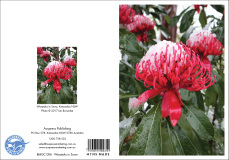- Greeting Cards
- >
- Blue Mountains Cards 125mm x 175mm
- >
- BMGC006 Waratahs in Snow greeting card
BMGC006 Waratahs in Snow greeting card
SKU:
BMGC006
A$2.95
A$2.95
Unavailable
per item
Blue Mountains series Greeting Card & envelope packed in cello bag.
Photography by Ian Brownlee.
Folded card size: 125mm x 175mm.
Price includes GST.
Licensed with Australian Made Campaign
This Blue Mountains Series reflects photographer Ian Brownlee's love of this ancient wilderness area – its valleys, streams, flora and fauna.
The Blue Mountains National Park is a protected national park that is located in the Blue Mountains region of New South Wales, in eastern Australia. The 267,954-hectare (662,130-acre) national park is situated approximately 80 kilometres (50 miles) west of Sydney, and the park boundary is quite irregular as it is broken up by roads, urban areas and inholdings. Despite the name 'mountains', the area is an uplifted plateau, dissected by a number of larger rivers. The highest point in the park is Mount Werong at 1,215 metres (3,986 ft) above sea level; while the low point is on the Nepean River at 20 metres (66 ft) above sea level as it leaves the park.
The national park is one of the eight protected areas that, in 2000, was inscribed to form part of the UNESCO World Heritage–listed Greater Blue Mountains Area. The Blue Mountains National Park is the most central of the eight protected areas within the World Heritage Site and it forms part of the Great Dividing Range. The park is also listed on the Australian Heritage Register and the overall complex of Blue Mountains regional walking tracks is listed on the State Heritage Register.
The Blue Mountains National Park is a protected national park that is located in the Blue Mountains region of New South Wales, in eastern Australia. The 267,954-hectare (662,130-acre) national park is situated approximately 80 kilometres (50 miles) west of Sydney, and the park boundary is quite irregular as it is broken up by roads, urban areas and inholdings. Despite the name 'mountains', the area is an uplifted plateau, dissected by a number of larger rivers. The highest point in the park is Mount Werong at 1,215 metres (3,986 ft) above sea level; while the low point is on the Nepean River at 20 metres (66 ft) above sea level as it leaves the park.
The national park is one of the eight protected areas that, in 2000, was inscribed to form part of the UNESCO World Heritage–listed Greater Blue Mountains Area. The Blue Mountains National Park is the most central of the eight protected areas within the World Heritage Site and it forms part of the Great Dividing Range. The park is also listed on the Australian Heritage Register and the overall complex of Blue Mountains regional walking tracks is listed on the State Heritage Register.



